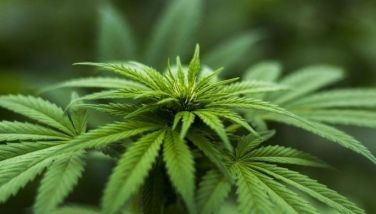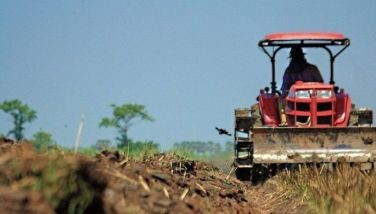Zamboanga puts up 1st seaweed gene bank, nursery
April 1, 2007 | 12:00am
ZAMBOANGA CITY  Seaweed farmers in Western Mindanao will soon have a regular source of quality seedlings because of the establishment of a seaweed gene bank and nursery at the Rio Hondo campus of the Zamboanga State College of Marine Science and Technology (ZSCMST).
Composed of fiberglass tanks fitted with aerators, the facility, which cost P1.7 million, was created through the joint efforts of ZSCMST officials and experts from the Southeast Asian Fisheries Development Center Aquaculture Department (SEAFDEC-AQD).
The first of its kind in Zamboanga Peninsula, the seaweed gene bank and nursery will provide a source of high quality strains of Kappaphycus alvarezii, also known as Eucheuma cottoni, from which carrageenan, a hydrocolloid is extacted. Initially four local strains of Kappaphycus, which include "tambalang", "vanguard", "adik-adik" and "sakol," were collected from seaweed farms in "Eleven Islands" and "Arena Blanco. Additional seaweed strains from Luzon, the Visayas, and other parts of Mindanao will be collected in the near future.
The Philippines is the world’s leading producer of carrageenan, which has varied uses in food, pharmaceutical and cosmetic industries. Last year, the country produced approximately 1.34 million metric tons (MT) of fresh seaweeds, mostly Kappaphycus, worth P6.04 billion, at current prices.
Mindanao  led by the ARMM and the Zamboanga Peninsula  remains the country’s major Kappaphycus producer, contributing 55 percent of total harvest in 2005, according to the Department of Agriculture’s Bureau of Agricultural Statistics (BAS).
The construction of the facility was supported by the USAID’s Growth with Equity in Mindanao (GEM) Program and the Zamboanga City Council, which is currently conducting a public hearing on a proposed ordinance granting incentives to the seaweed industry.
The establishment of a seaweed gene bank and nursery in Zamboanga is critical to the seaweed industry because the quality of local seaweeds has been deteriorating through the years. Farmers have been overly reliant on cuttings from previous harvests, which have become less productive and susceptible to diseases. Experiments are currently underway to determine which strains of seaweed are most high-yielding, disease-resistant, and produce the best type of carrageenan.
Another seaweed gene bank and nursery will soon be constructed in Bongao, Tawi-Tawi, as agreed by industry stakeholders during the 1st Provincial Economic and Environment Summit of Tawi-Tawi, held in September. That facility will be constructed by the Mindanao State University-Tawi-Tawi College of Tecnology and Oceanography, the Philippine Development Assistance Program, BFAR-ARMM, Tawi-Tawi Chamber of Commerce and Industry, and WMSIDFI.
The facility, will also receive support from the GEM Program, and will enhance Tawi-Tawi’s seaweed production. It is the country’s largest seaweed producer, and harvested 281,000 MT of fresh seaweeds in 2005.
GEM seaweed industry advisor Alfredo Isidro said that GEM has worked closely with key industry stakeholders to further increase the region’s seaweed production. The new facility will complement the seaweed solar driers and warehouses that GEM has constructed in support of increased seaweed production.
In addition, GEM and WMSIDFI funded an extensive two-month training course on seaweed micro-propagation techniques and laboratory culture methods. The course was taught by three experts of the UP Marine Science Institute.
For more than four years, GEM has been providing technical assistance to WMSIDFI, the Inter-Agency Seaweed Task Force of Region 9, Provincial Technical Working Group of Tawi-Tawi, and the National Technical Working Committee of the National Seaweed Program to enhance the competitiveness of Philippine seaweeds and carrageenan in the global market.  GEM Program
Composed of fiberglass tanks fitted with aerators, the facility, which cost P1.7 million, was created through the joint efforts of ZSCMST officials and experts from the Southeast Asian Fisheries Development Center Aquaculture Department (SEAFDEC-AQD).
The first of its kind in Zamboanga Peninsula, the seaweed gene bank and nursery will provide a source of high quality strains of Kappaphycus alvarezii, also known as Eucheuma cottoni, from which carrageenan, a hydrocolloid is extacted. Initially four local strains of Kappaphycus, which include "tambalang", "vanguard", "adik-adik" and "sakol," were collected from seaweed farms in "Eleven Islands" and "Arena Blanco. Additional seaweed strains from Luzon, the Visayas, and other parts of Mindanao will be collected in the near future.
The Philippines is the world’s leading producer of carrageenan, which has varied uses in food, pharmaceutical and cosmetic industries. Last year, the country produced approximately 1.34 million metric tons (MT) of fresh seaweeds, mostly Kappaphycus, worth P6.04 billion, at current prices.
Mindanao  led by the ARMM and the Zamboanga Peninsula  remains the country’s major Kappaphycus producer, contributing 55 percent of total harvest in 2005, according to the Department of Agriculture’s Bureau of Agricultural Statistics (BAS).
The construction of the facility was supported by the USAID’s Growth with Equity in Mindanao (GEM) Program and the Zamboanga City Council, which is currently conducting a public hearing on a proposed ordinance granting incentives to the seaweed industry.
The establishment of a seaweed gene bank and nursery in Zamboanga is critical to the seaweed industry because the quality of local seaweeds has been deteriorating through the years. Farmers have been overly reliant on cuttings from previous harvests, which have become less productive and susceptible to diseases. Experiments are currently underway to determine which strains of seaweed are most high-yielding, disease-resistant, and produce the best type of carrageenan.
Another seaweed gene bank and nursery will soon be constructed in Bongao, Tawi-Tawi, as agreed by industry stakeholders during the 1st Provincial Economic and Environment Summit of Tawi-Tawi, held in September. That facility will be constructed by the Mindanao State University-Tawi-Tawi College of Tecnology and Oceanography, the Philippine Development Assistance Program, BFAR-ARMM, Tawi-Tawi Chamber of Commerce and Industry, and WMSIDFI.
The facility, will also receive support from the GEM Program, and will enhance Tawi-Tawi’s seaweed production. It is the country’s largest seaweed producer, and harvested 281,000 MT of fresh seaweeds in 2005.
GEM seaweed industry advisor Alfredo Isidro said that GEM has worked closely with key industry stakeholders to further increase the region’s seaweed production. The new facility will complement the seaweed solar driers and warehouses that GEM has constructed in support of increased seaweed production.
In addition, GEM and WMSIDFI funded an extensive two-month training course on seaweed micro-propagation techniques and laboratory culture methods. The course was taught by three experts of the UP Marine Science Institute.
For more than four years, GEM has been providing technical assistance to WMSIDFI, the Inter-Agency Seaweed Task Force of Region 9, Provincial Technical Working Group of Tawi-Tawi, and the National Technical Working Committee of the National Seaweed Program to enhance the competitiveness of Philippine seaweeds and carrageenan in the global market.  GEM Program
BrandSpace Articles
<
>
- Latest
Latest
Latest
March 4, 2024 - 3:32pm
By Ian Laqui | March 4, 2024 - 3:32pm
March 4, 2024 - 2:12pm
By Kristine Daguno-Bersamina | March 4, 2024 - 2:12pm
February 17, 2024 - 2:31pm
February 17, 2024 - 2:31pm
February 13, 2024 - 7:24pm
By Gaea Katreena Cabico | February 13, 2024 - 7:24pm
February 13, 2024 - 7:17pm
By Ian Laqui | February 13, 2024 - 7:17pm
Recommended




























